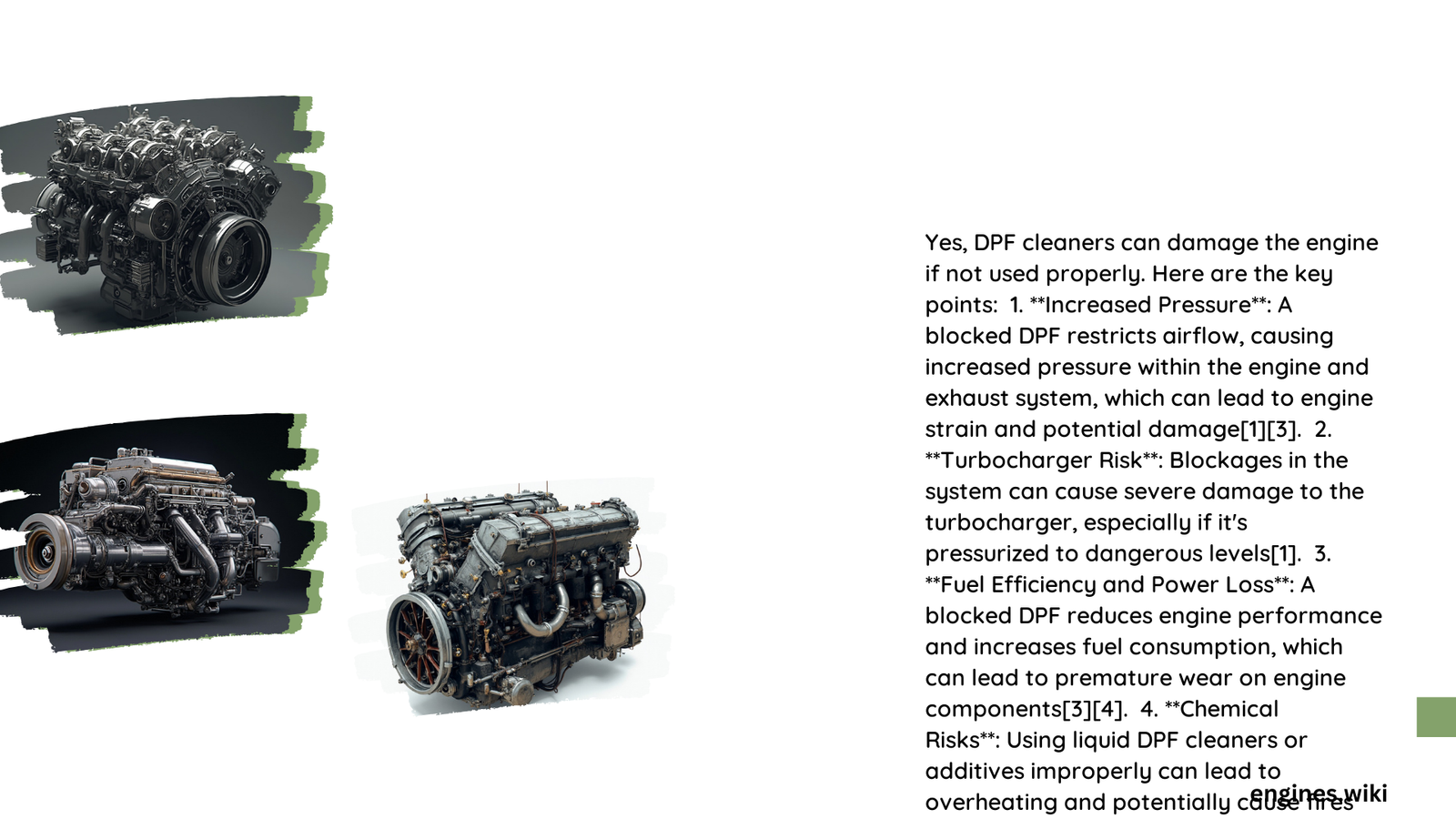DPF cleaners are designed to remove soot and other particulates from diesel particulate filters. While generally safe when used correctly, improper application or overuse of DPF cleaners can potentially damage engine components. The risk of damage depends on factors such as the cleaner’s chemical composition, application method, and engine type. This article explores the potential risks associated with DPF cleaners and provides guidelines for safe usage to minimize the chance of engine damage.
What Are the Potential Risks of Using DPF Cleaners?
DPF cleaners, while effective in maintaining the performance of diesel particulate filters, can pose certain risks to engine components if not used properly. Here are some potential risks:
- Chemical Interactions: Some DPF cleaners contain harsh chemicals that may react with engine materials.
- Residue Build-up: Improper application can lead to residue accumulation in the engine.
- Sensor Damage: Overuse or misuse may affect oxygen sensors or other sensitive components.
- Catalytic Converter Issues: Excessive use can potentially impact the catalytic converter’s performance.
- Fuel System Contamination: If not applied correctly, the cleaner may enter the fuel system.
How Do Different DPF Cleaner Compositions Affect Engine Safety?

The chemical composition of DPF cleaners varies among manufacturers, and these differences can impact their potential to cause engine damage. Let’s examine some common ingredients and their effects:
Petroleum Distillates
- Found in products like Silverhook Ltd’s DPF Cleaner
- Can cause lung damage if swallowed and enters airways
- May damage organs through prolonged exposure
Ethanolamine
- Present in RETECH’s DPF Cleaner
- Can cause skin corrosion and acute toxicity
- Potential for chemical reactions with engine components
Metal-Free Formulas
- Used in products like Wurth’s DPF Cleaner
- Generally safer for engine components
- Less likely to leave harmful residues
What Are the Recommended Usage Guidelines for DPF Cleaners?
To minimize the risk of engine damage, it’s crucial to follow the manufacturer’s guidelines for DPF cleaner application. Here are some general recommendations:
- Ensure proper ventilation during application
- Use respiratory protection if ventilation is inadequate
- Apply the cleaner when the exhaust system is cool (below 50°C or 122°F)
- Follow the recommended dosage for your vehicle type
- Initiate manual regeneration after application, if required
- Avoid mixing different DPF cleaners or using with other chemicals
Can DPF Cleaners Affect Different Types of Diesel Engines Differently?
While specific data on the effects of DPF cleaners on different engine types is limited, there are some considerations:
Turbocharged Engines
- May be more sensitive to chemical residues
- Require careful application to avoid turbocharger damage
Naturally Aspirated Engines
- Generally less complex, potentially less susceptible to damage
- Still require proper application techniques
Common-Rail Diesel Engines
- High-pressure fuel systems may be more vulnerable to contamination
- Extra care needed to prevent cleaner from entering the fuel system
What Preventive Measures Can Protect Engines from DPF Cleaner Damage?
To safeguard your engine when using DPF cleaners, consider these preventive measures:
- Choose the right product: Select a DPF cleaner compatible with your engine type
- Follow instructions meticulously: Adhere to the manufacturer’s guidelines
- Use proper equipment: Employ recommended application tools and methods
- Regular maintenance: Keep your DPF and engine in good condition to reduce the need for frequent cleaning
- Professional application: Consider having a trained technician apply the cleaner
How Often Should DPF Cleaners Be Used Safely?
The frequency of DPF cleaner use depends on various factors:
| Driving Conditions | Recommended Frequency |
|---|---|
| City driving | Every 3,000-5,000 miles |
| Highway driving | Every 7,000-10,000 miles |
| Heavy-duty use | As per manufacturer’s recommendation |
Note: These are general guidelines. Always consult your vehicle’s manual or a professional for specific recommendations.
What Are the Signs of Engine Damage from DPF Cleaner Misuse?
Be alert for these potential indicators of engine damage due to improper DPF cleaner use:
- Unusual engine noises
- Decreased performance or power
- Increased fuel consumption
- Check engine light activation
- Excessive exhaust smoke
- Difficulty starting the engine
If you notice any of these signs after using a DPF cleaner, consult a professional mechanic immediately.
Can Alternative DPF Maintenance Methods Reduce the Risk of Engine Damage?
While DPF cleaners are effective, consider these alternative maintenance methods to reduce reliance on chemical cleaners:
- Regular highway driving to promote natural regeneration
- Ensuring proper engine oil and fuel quality
- Avoiding short trips that prevent the DPF from reaching optimal operating temperature
- Following manufacturer-recommended service intervals
- Using fuel additives designed to reduce soot formation
By incorporating these practices, you may reduce the frequency of DPF cleaner use and minimize potential risks to your engine.
In conclusion, while DPF cleaners can be effective tools for maintaining diesel particulate filters, they must be used with caution to avoid potential engine damage. By following manufacturer guidelines, using the correct product for your engine, and implementing preventive measures, you can minimize the risks associated with DPF cleaner use and maintain your engine’s health and performance.
References:
1. SAFETY DATA SHEET Diesel Particulate Filter Cleaner – Cloudinary
2. Diesel Particulate Filter Cleaner with Hose (Aerosol Can – 400 mL) – Wurth USA
3. DPF CLEANER – RETECH
